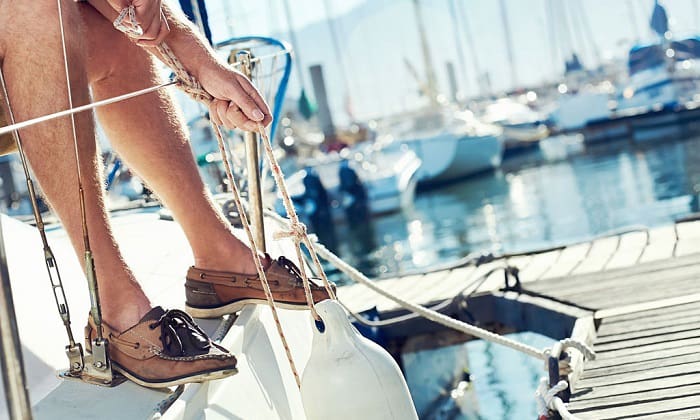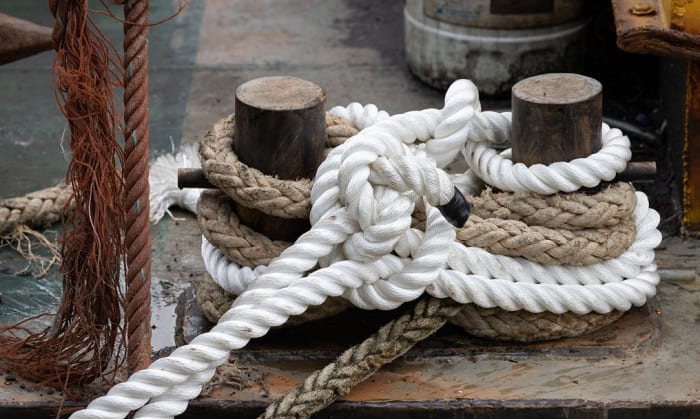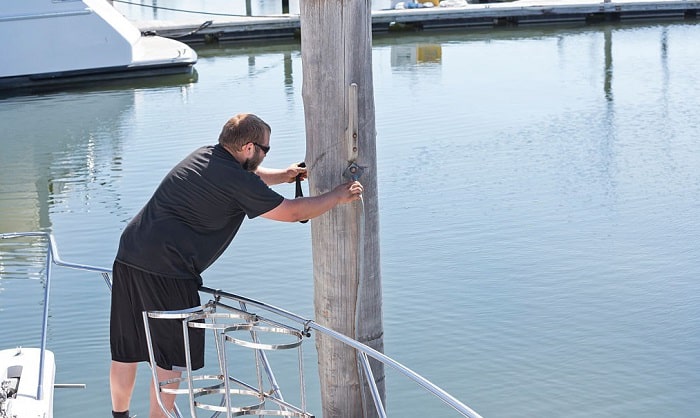Have you ever tried mooring your boat on a berth without cleats? You might be surprised to learn that many docks in the US do not have these all-important structures. But it should not be a problem if you know how to tie a boat to a dock without cleats.
Cleats are crucial dock elements for securing boats and other water vessels. However, there are other structures where you can tie and secure a watercraft. I will share several tips for mooring a boat on a cleatless dock.
Table of Contents
Things You Will Need for This Guide
The only thing you will need to tie your boat to a cleat-less dock is a rope, line, or cable. I presume you already have these things in your watercraft. In that case, the other thing you must prepare for is knowledge of common knots.
For example, a clove hitch is perfect for securing the boat to a railing or dock ring. A more versatile knot is the bowline, which allows you to fasten almost anything to a sturdy structure. However, if the port only has pilings or posts, a good bet is a pile hitch knot.
The figure-8 knot is suitable for securing a watercraft to its berth, while a square knot is perfect for bundling objects together and joining two lines. An anchor bend is ideal for boat owners who want the most secure solution for tying their boats. It can be tricky to make, but it is worth it.
Other knots you might want to learn and master are the double half hitch, sheet bend knot, wagoner’s hitch, and alternative clove hitch.
I recommend practicing these knots at home before heading out into the water.
Steps for Tying a Boat to a Dock Without Cleats
Step 1: Practice making the bowline knot until you master it
The bowline is the most convenient and secure way to tie a boat to a piling without cleats in the dock. Although the bowline is a simple knot, boaters love it because it does not loosen easily. Nevertheless, undoing the tie is a breeze.
Not only is the bowline perfect for mooring a boat to a piling, but it also works with dock rings. You can also prepare the knot beforehand and insert it over the post once you reach the berth.
Using the bowline knot, you can tie a boat to a dock overnight and return the following day confident your boat is still in its berth.
You can also adjust a bowline knot to suit different purposes without losing its easy-to-use and secure attributes. You might be surprised to learn this knot is also a favorite of pilots to secure their light aircraft.
So, how do you make a bowline knot?
First, wrap the rope around a piling or post and grab the cable’s end section before crossing the long end over itself to create a small loop. Next, insert the rope’s short end into said loop, and do this again after bringing the short end over the rope. Lastly, pull the line to tighten the knot.
Here is a video from Salt Strong showing you how to make the bowline knot.
Pro tip: You can use this knot to tie a boat to 4 pilings for better security.
Step 2: Master the Art of Making a Clove Hitch
Another method for tying a boat between pilings is the clove hitch knot, which is also suitable for railings and dock rings. Like the bowline knot, the clove hitch is easy to execute and undo. The only downside is that it can loosen without weight bearing down on it. Your boat should keep the knot secure.
Many boaters prefer the clove hitch to the bowline when mooring to load and unload their cargo. Its ease of application and removal makes it among the best knots to use.
Here are the steps for making a clove hitch.
First, wrap the rope around the railing, dock ring, or piling, ensuring the long section is over the short end. Next, grab the short end and wrap it over the rope’s long end before looping the short end around the piling again. Lastly, insert the short end through the intersecting lines and pull as tightly as you can.
Like the bowman, you can also prepare this knot beforehand. Create a loop with the long end over the short section. Grab the short portion and form a second loop, ensuring the short end is under the long line. Position the second loop on top of the first loop and insert it over a post or piling.
Adlard Coles has an exciting video on the two ways you can make a clove hitch knot.
Step 3: Study how to make a pile hitch
The pile hitch knot is your best bet if you need a secure way to tie a boat to a mooring. It requires making a mooring rope fold and wrapping the resulting loop around the post. This method is perfect for pilings and similar structures but not as a permanent hitch.
The only downside here is the rope must be sufficiently long.
You will need to form a double line by folding a long section of the rope before wrapping the folded line around the post or piling. Next, insert the folded end under itself and wrap the loop around the vertical structure or piling. Lastly, tug the rope to tighten the pile hitch knot.
Step 4: Secure your boat to a piling using your preferred method
Maneuver your boat to its berth and get on the dock, ensuring you do not hit anything. It would be best to judge the water, wind, and current conditions as you steer your boat slowly towards the mooring area. Take it slow.
Secure your watercraft to a piling, post, railing, or dock ring if cleats are unavailable. It will be wise to remember that the bowline and clove hitch knots are suitable for almost any mooring structure. If the dock only has posts or pilings, I recommend sticking with a pile hitch knot.
Conclusion
Knowing how to tie a boat to a dock without cleats is an essential skill all boaters should have. I shared three of the most popular ways to secure a watercraft to a cleat-less mooring area, but there are other types of knots you can use to secure a boat in its berth. But if the cleats are available, you may take a look at this post to find the easiest way to tie a boat to a cleat.
Please share this article with your friends if you found it valuable. I also would love to hear your comments and thoughts about this guide. So, please drop me a line or two.

Ten years of enjoying countless trips on boats never made me love them any less! So I am here to put all those experiences into good use for other boaters who want to have a safe and fun trip with their friends and families.



